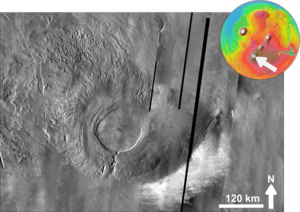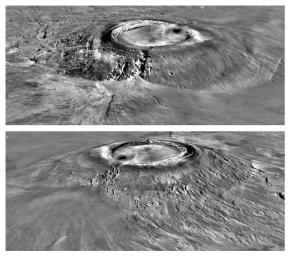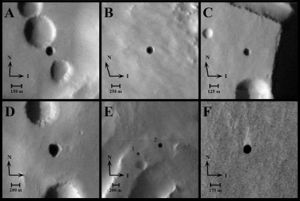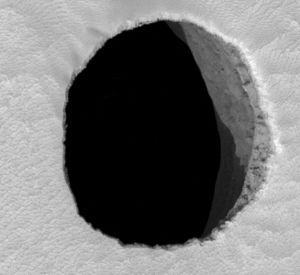Difference between revisions of "Arsia Mons"
m |
m (→Caves) |
||
| Line 8: | Line 8: | ||
===Caves=== | ===Caves=== | ||
| − | Seven [[cave]] entrances have been discovered on the sides of Arsia Mons. These caves could contain reserves of [[water ice]] or even life. They are possible locations for a [[volcanic cave settlement|cave settlement]]. With the low gravity of Mars, lava tubes may be over 800 feet in width. A | + | Seven [[cave]] entrances have been discovered on the sides of Arsia Mons. These caves could contain reserves of [[water ice]] or even life. They are possible locations for a [[volcanic cave settlement|cave settlement]]. With the low gravity of Mars, lava tubes may be over 800 feet in width. A lava tube on Mars could protect colonists from meteorites and radiation. Because of the lack of a magnetic field at present, Mars has a fair amount of radiation, especially from cosmic ray sources.<ref>https://www.sciencedaily.com/releases/2017/09/170925112842.htm</ref> A mini-series produced by National Geographic in 2016 depicted how people could establish a base in a cave.<ref>https://www.nationalgeographic.org/education/mars</ref> <ref>https://www.leonarddavid.com/underground-caves-on-moon-mars-protected-habitats-for-explorers/</ref> |
[[File: Mars caves from NASA orbiters.jpg|thumb|right|Possible cave entrances These openings have been named (A) "Dena," (B) "Chloe," (C) "Wendy," (D) "Annie," (E) "Abby" (left) and "Nikki," and (F) "Jeanne."]] | [[File: Mars caves from NASA orbiters.jpg|thumb|right|Possible cave entrances These openings have been named (A) "Dena," (B) "Chloe," (C) "Wendy," (D) "Annie," (E) "Abby" (left) and "Nikki," and (F) "Jeanne."]] | ||
Revision as of 12:14, 26 April 2018
Arsia Mons is an extinct shield volcano in the Tharsis region near the equator. It is part of the Tharsis Montes group of volcanos. Its location is 8.35 S and 120.09 W (239.91 E) in the Phoenicis Lacus quadrangle. Its name is a classical feature name and comes from a corresponding albedo feature on a map by Giovanni Schiaparelli, which he named in turn after the legendary Roman forest of Arsia Silva.[1] Researchers have found much evidence for glaciers on Arsia Mons.[2] [3]
Caves
Seven cave entrances have been discovered on the sides of Arsia Mons. These caves could contain reserves of water ice or even life. They are possible locations for a cave settlement. With the low gravity of Mars, lava tubes may be over 800 feet in width. A lava tube on Mars could protect colonists from meteorites and radiation. Because of the lack of a magnetic field at present, Mars has a fair amount of radiation, especially from cosmic ray sources.[4] A mini-series produced by National Geographic in 2016 depicted how people could establish a base in a cave.[5] [6]
References:
- ↑ https://planetarynames.wr.usgs.gov/Page/MARS/target
- ↑ Scanlon, K., J. Head, D. Marchant. 2015. REMNANT BURIED ICE IN THE ARSIA MONS FAN-SHAPED DEPOSIT, MARS. 46th Lunar and Planetary Science Conference. 2266.pdf
- ↑ "Recent glaciation at high elevations on Arsia Mons, Mars: Implications for the formation and evolution of large tropical mountain glaciers" (PDF) (2007). Journal of Geophysical Research 112 (E3). doi:.
- ↑ https://www.sciencedaily.com/releases/2017/09/170925112842.htm
- ↑ https://www.nationalgeographic.org/education/mars
- ↑ https://www.leonarddavid.com/underground-caves-on-moon-mars-protected-habitats-for-explorers/
| This article is a stub. You can help Marspedia by expanding it. |










